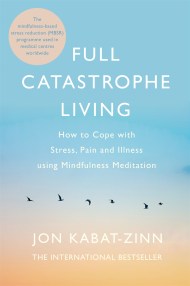Mindfulness in the office: tips for reducing work stress

Work and office life is one of the main causes of stress in today’s world but by bringing mindfulness practice into your work life you can make major improvements in the quality of your life at work no matter what your job. In this exclusive extract from his book, Full Catastrophe Living, Jon Kabat-Zinn provides advice for using mindfulness techniques to reduce stress in your professional life.
When you introduce mindfulness as the thread guiding your seeing and your actions from moment to moment and from day to day, at work, as you get up in the morning and prepare to go to work, and as you leave to come home, work really becomes something you are choosing to do, every day, in a way that goes beyond the necessity of having a job to make money or to ‘get somewhere’ in life. Rather than having work run your life completely, you are now in a position to be in greater balance with it.
True, there are obligations and responsibilities and pressures that you have to face and deal with, which may be beyond your control, and which may cause you stress, but is that not the same in every other aspect of your life as well? If it were not one set of pressures, would it not be another after a short time? You need to eat. You need connection to the larger world one way or another. There will always be some aspect of the full catastrophe to be faced somewhere, sometime. It is how you face it that matters.
1. When you wake up, take a few quiet moments to affirm that you are choosing to go to work today. If you can, briefly review what you think you will be doing and remind yourself that it may or may not happen that way.
2. Bring awareness to the whole process of preparing to go to work. This might include showering, dressing, eating, and relating to the people you live with. Tune in to your breathing and your body from time to time.
3. When leaving the house, don’t say good-bye mechanically to people. Make eye contact with them, touch them; really be ‘in’ those moments, slowing them down just a bit. If you leave before other people wake up, you might try writing them a brief note to say good morning and express your feelings toward them.
4. If you walk to public transportation, be aware of your body breathing, walking, standing and waiting, riding, and getting off . Walk into work mindfully. As best you can, leave your mobile phone alone. Try smiling inwardly. If driving, take a moment or two to come to your breathing before you start the car. Remind yourself that you are about to drive off to work now. Some days, at least, try driving without the radio on. Just drive and be with yourself, moment by moment. Leave your mobile phone alone. When you park, take a moment or two to just sit and breathe before you leave the car. Walk into work mindfully. Breathe. If your face is already tense and grim, try smiling, or try a half smile if that is too much.
5. At work, take a moment from time to time to monitor your bodily sensations. Is there tension in your shoulders, face, hands, or back? How are you sitting or standing in this moment? What is your body language saying? Consciously let go of any tension as best you can as you exhale and shift your posture to one that expresses balance, dignity, and alertness.
6. When you find yourself walking at work, take the edge off it. Walk mindfully. Don’t rush unless you have to. If you have to, know that you are rushing. Rush mindfully.
7. Try doing one thing at a time and giving it the full attention that it deserves for as long as it deserves, without distracting yourself or allowing yourself to be distracted, such as by incoming emails and texts. Overall, the evidence from studies shows that not only does multitasking not work, it degrades performance on every task you are trying to juggle.
8. Take frequent breaks if you can and use them to truly relax and renew. Instead of drinking coffee or smoking a cigarette, try going outside the building for three minutes and walking or standing and breathing. Or do neck and shoulder rolls at your desk. Or shut your office door if you can and sit quietly for five minutes or so, following your breathing.
9. Spend your breaks and lunchtime with people you feel comfortable with. Otherwise, maybe it would be better for you to be alone. Changing your environment at lunch can be helpful. Choose to eat one or two lunches a week in silence, mindfully.
10. Alternatively, don’t eat lunch. Go out and exercise, every day if you can, or a few days a week. Exercise is a great way of reducing stress. Your ability to do this will depend on how much flexibility you have in your job. If you can do it, it is a wonderful way of clearing the mind, reducing your tension, and starting the afternoon refreshed and with a lot of energy. Many workplaces now have wellness centers that provide organized employee exercise programs both at lunchtime and before and after work. If you have the opportunity to exercise at work, take it! But remember, an exercise program takes the same kind of commitment that the formal meditation takes. And when you do it, do it mindfully. That changes everything.
11. Try to stop for one minute every hour and become aware of your breathing. We waste far more time than this daydreaming at work. Use these mini meditations to tune in to the present and just be. Use them as moments in which to regroup and recoup. All it takes is remembering to do it. This one is not easy, since we so easily get carried away by the momentum of all the doing.
12. Use everyday cues in your environment as reminders to center yourself and relax—the telephone ringing, downtime before a meeting convenes, waiting for someone to finish something before you can start in on it. Instead of relaxing by ‘spacing out’, relax by tuning in.
13. Be mindful of your communications with people during the workday. Are they satisfying? Are some problematic? Think about how you might improve them. Be aware of people who tend to relate to you in a passive or a hostile mode. Think about how you might approach them more effectively. Try seeing your fellow employees with eyes of wholeness. Think about how you might be more sensitive to their feelings and needs. How might you help others at work by being more mindful and more heartful? How might awareness of tone of voice and body language, your own and that of others, help you when communicating?
14. At the end of the day, review what you have accomplished and make a list of what needs to be done tomorrow. Prioritize the items on your list so that you know what is most important.
15. As you are leaving work, bring your awareness to walking and breathing again. Be aware of the transition we call ‘leaving work’. Monitor your body. Are you exhausted? Are you standing erect or bent over? What expression is on your face? Are you in the present moment, or are you getting out ahead of yourself in your thinking mind?
16. If you are taking public transportation, bring your attention to your breathing, walking, standing, and sitting. Notice if you are rushing. Can you back it down a bit and own those moments between work and home as much as any of your other moments to live? Be aware of the impulse to fill them up by being on your phone. As much as possible, be aware of the impulse to use it, and leave it alone to whatever degree possible. Just see if you can be in your own good company for at least some of this time. Or, if you are driving, take a moment or two once again to sit in your car before you start it up. Drive home mindfully. Leave the cell phone alone unless it is hands-free and essential that you make the call then and not later. Can you be aware of that decision? Can you be aware of the impulse to simply ignore your decision and make the call anyway?
17. Before you walk in the door, realize that you are about to do so. Be aware of this transition we call ‘coming home’. Try greeting people mindfully and making eye contact rather than shouting to announce your arrival.
18. As soon as you can, take your shoes off and get out of your work clothes. Changing to other clothes can complete the transition from work to home and allow you to integrate more quickly and consciously into your non-work roles. If you can make the time, take five minutes or so to meditate before you do anything else, even cooking or eating dinner.
19. Keep in mind that the real meditation is how you live your life from moment to moment. In this way, everything you do can become part of your meditation practice, if you are willing to inhabit the present moment and embrace it in awareness, in your body, ‘underneath’ thinking.
THE LANDMARK INTERNATIONAL BESTSELLER ON MINDFULNESS, MEDITATION AND HEALING
Stress. It can sap our energy, undermine our health and even shorten our lives. It makes us more vulnerable to anxiety and depression, disconnection and disease. Based on Jon Kabat-Zinn's renowned mindfulness-based stress reduction programme, this classic, ground-breaking work which gave rise to a whole new field in medicine and psychology - shows you how to use medically proven mind-body approaches derived from meditation and yoga to counteract stress, establish greater balance of body and mind, and stimulate well-being and healing. By engaging in these mindfulness practices and integrating them into your life from moment to moment and from day to day, you can learn to manage chronic pain, promote optimal healing, reduce anxiety and feelings of panic, and improve the overall quality of your life, relationships, and social networks.
Full Catastrophe Living is a book for the young and the old, the well and the ill, and anyone trying to live a healthier and saner life in our fast-paced world.
'To say that this wise, deep book is helpful to those who face the challenges of human crisis would be a vast understatement. It is essential, unique, and, above all, fundamentally healing.' Donald M. Berwick, president emeritus and senior fellow, Institute for Healthcare Improvement









